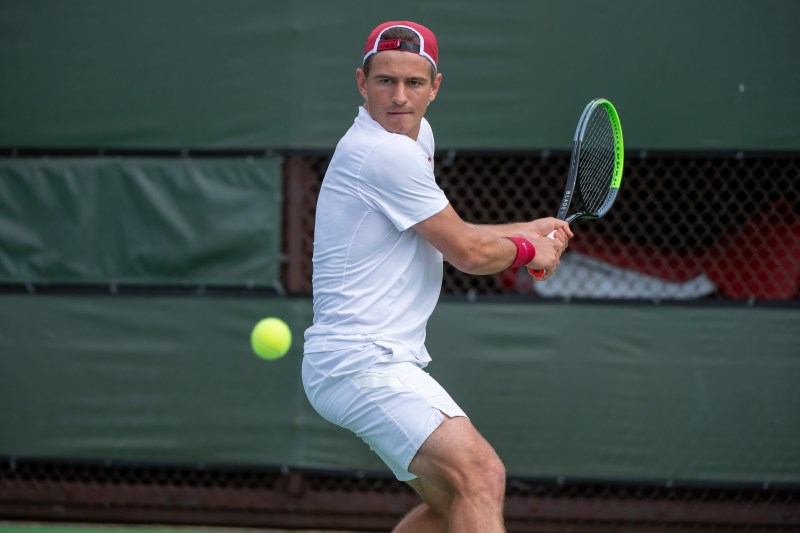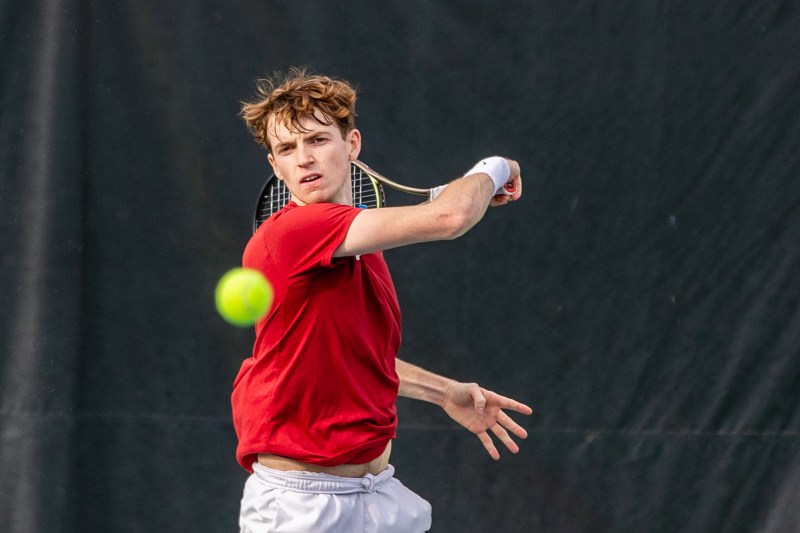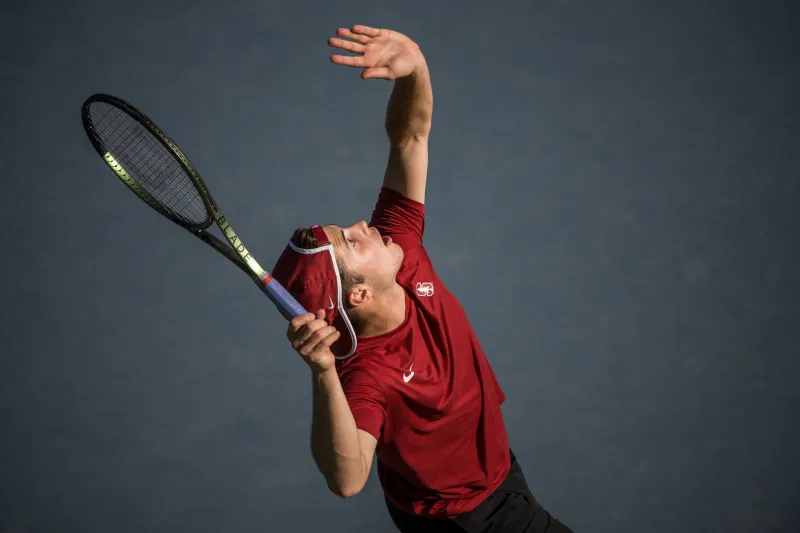Stanford senior Filip Kolasinski can envision the different paths his tennis career might have taken simply by looking at the group of players he trained with back home in Poland.
Some now work or attend university in Europe, playing tennis only in their free time; others took coaching jobs. It’s a far cry from four years ago, when their schedules necessitated online high school, practicing four to five hours a day and traveling 25 to 30 weeks per year for tournaments and training. Several within this group of Polish junior players decided to turn pro, Kolasinski said, but it has been challenging for them.
Four years into their professional careers, some are still barely able to break even financially, Kolasinski explained, in spite of achieving decent on-court results. “I think the important thing is that you have to be really, really good in tennis to make significant money,” he said. “Because the costs of basically training and traveling are so high.”
Kolasinski, a Warsaw native once ranked among the top 100 juniors in the world, ultimately took a different route: NCAA Division I tennis. He is one of an increasing number of international players who are choosing to postpone or forgo professional careers in favor of additional years of competition and education at American universities.
And while collegiate tennis in the United States has long been an option for non-domestic players, athletes and coaches say that the financial incentives, professional opportunities and motivations for prospective international student-athletes have only grown in recent years.
According to an NCAA Research report published in December 2022, 61% of male and 66% of female Division I tennis players are international students, up from approximately 38% and 50% reported in 2006-2007. Many attribute this large increase to high-profile professional players who successfully transitioned from collegiate tennis to pro careers. Currently, 15 men in the Association of Tennis Professionals (ATP) top 100 are former college players, and six of those are in the top 50.
Recent talent to emerge from the collegiate sphere includes the American phenom, Ben Shelton, who won the 2022 NCAA singles and team titles for the University of Florida and reached a major quarterfinal less than a year after turning pro; American Danielle Collins, a two-time NCAA singles champion at the University of Virginia and now Australian Open finalist; the top-ranked British male, Cameron Norrie, who held the No. 1 national collegiate ranking in singles while at Texas Christian University; and Diana Shnaider from Russia, who spent this past season alternating between dual matches for North Carolina State and various pro events, scoring her first two major match wins in 2023.
“The success of some of the collegiate players on tour has increased the viability for international student-athletes to consider college as a pathway to professional tennis,” said Stanford men’s tennis head coach Paul Goldstein.
Students can also benefit financially from playing pro events while at school, though only to a certain extent. NCAA eligibility rules state that Division I tennis players may collect up to $10,000 in prize money from professional tournaments each calendar year. Any additional money accepted after reaching that limit may not exceed the athlete’s expenses for participating in an event.
The ATP announced an additional incentive last January, unveiling a partnership with the Intercollegiate Tennis Association (ITA). The top 20 players in the June ITA rankings and any other player who reaches the quarterfinals of the NCAA Tournament singles draw will now be awarded wildcards into Challenger 50 and 75 events, entry-level tournaments designed to provide upward mobility to lower-ranked players. Those ranked in the top 10 will be entered into a tournament’s main draw, while Nos. 11-20 will gain still sought-after places in qualifying brackets. These opportunities, the ATP said in a statement, are intended to help the next generation of collegiate athletes jumpstart their professional careers.
Stanford junior Arthur Fery will be in the first cohort to benefit from the initiative, as both a member of the ITA top 20 and a 2023 NCAA singles quarterfinalist. Fery took the fall quarter off from school to play lower-level International Tennis Federation (ITF) tournaments, winning his first three entry-level M25 events. Last week, it was announced that he will now pursue professional tennis full-time after three years playing for Stanford.
Fery is not an outlier in opting to develop his game through collegiate tennis. International players held 34 of the 64 spots in the initial NCAA men’s singles draw this year and 26 of 64 in the women’s draw.

“There was this perception [overseas that] going to college basically means you’re ending your professional career, which is definitely not the case,” Kolasinski said, adding that he believes the ATP-ITA program and the presence of former college players in the top 100 will further incentivize international juniors to pursue NCAA competition. “The level of college tennis is just incredibly high, and it’s getting higher and higher.”
International players are also attracted by the opportunity to combine tennis and academics. A fellow student recently asked Stanford sophomore Max Basing what college athletics look like back in the United Kingdom. His answer was straightforward: “It doesn’t really exist.”
“They don’t have that level of college sports, of funding, of facilities just all around the country where people can go and still take their sports seriously and pursue an education,” said Basing, who comes from Oxshott in Surrey, England, and trained in Mallorca, Spain.
American universities also appeal to many international students because they allow more time to decide on an area of study, Stanford coach Goldstein said. In a number of other countries, students are required to choose concentrations at age 18 — or sometimes even earlier — to ensure they are taking the necessary prerequisites.
College coaches are able to pull from a global talent pool with more ease than was possible a couple of decades ago due to increased interest from recruits, a greater number of junior matches available through livestreams and an international network already in place. Both Goldstein and his assistant head coach, Brandon Coupe, played on the ATP tour.
The coaches often find many of these international recruits are highly prepared athletes who readily adjust to the demands of collegiate athletics.
“Pretty much by definition, they’re coming an even further distance,” Goldstein said of the international players he has recruited and coached since taking the Stanford program’s helm in 2014. “So their independence and maturity has been, thus far, high and we’ve had really good experiences.”
These additional years of training can be helpful physically and financially, as many professional players now are cracking the top 100 in their mid to late twenties instead of as teenagers.

“There’s not really a guarantee of money to fund the whole tour by traveling all year round,” said Basing, whose current plan is to finish his college career at Stanford and then turn pro. “So if you start young and it’s not quite going well, it’s kind of difficult to stay in it.” He had heard from friends about their positive experiences choosing the college route, which in turn piqued his interest.
This word-of-mouth from older athletes encourages many players to pursue NCAA tennis over other options. Though Kolasinski does not plan to turn pro after leaving Stanford, he still remembers the “invaluable advice” older international college players provided to him when he was a teenager. Now, as the next group of student-athletes are faced with the decision he grappled with four years ago, he tries to provide similar support whenever he can.
“I’m definitely trying to spread this knowledge right now to others,” Kolasinski said. “Because there are a lot of young kids who don’t really know where to start, and just giving them some guidance can be life-changing.
“I got the same guidance, and it definitely changed my life.”
